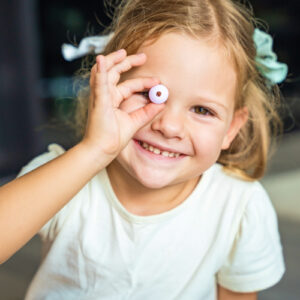- 541-884-3148
- info@klamatheyecenter.com
- 08:00AM to 5:00PM
Amblyopia
A Closer Look
What Causes Amblyopia?
Amblyopia (“lazy eye”) is caused by unequal refractive errors, misaligned eyes (strabismus) or other abnormalities.

How is Amblyopia Treated?
Patching is one technique for treating amblyopia. A patch is placed over the better-seeing eye to make the child use and develop good vision in the amblyopic (lazy) eye.Atropine eyedrops or ointment is another technique for treating amblyopia. The medication is placed in the better-seeing eye on a regular basis. Atropine works by blurring the vision in the better eye, forcing the child to use and develop good vision in the lazy eye. Your ophthalmologist (Eye M.D.) should instruct you on the proper use and frequency of the atropine.
When should Treatment Begin?
Treatment of amblyopia should begin as early as possible. If your child is old enough to understand, explain the reason for using the patch or atropine. It may be helpful to demonstrate patching on a doll.If your child attends school or preschool, explain the amblyopia treatment to the teacher. Enlist the teacher’s help to encourage your child to perform his or her usual tasks, while also making allowances for added difficulty from the treatment. The teacher can also help explain your child’s situation to classmates.

How Long Will the Treatment Take?
Treatment time will vary for different children. As a general rule, the younger the child is and the less amount of time the eye has been lazy, the shorter the length of treatment will be. In young children, vision may improve rapidly.
To ensure that a child is given the best possible chance to develop normal vision, the patching or atropine may be continued for a few weeks or months after vision stabilizes.
It’s important that your child continues wearing the patch or using the atropine as instructed by your ophthalmologist. Activities that hold the child’s interest will also encourage the use of the lazy eye and help speed visual recovery.
Once vision has improved in the lazy eye, there is a small chance that it can become worse again. Close observation of the eye is necessary throughout childhood.
It is important to note that patching or atropine improves vision in an amblyopic lazy eye, but does not help misaligned eyes. Once vision has improved, your ophthalmologist can recommend treatment for realigning the eyes.
If vision does not improve after a reasonable period, your ophthalmologist may recommend discontinuing treatment.
Are There Any Side Effects From Treatment?
Because the better-seeing eye is not used during treatment, occasionally vision in that eye may decrease, but it will usually return to normal as soon as that eye is used again.
The skin at and around a patched eye may become irritated. Trying a different type of patch or changing the shape of the patch may help relieve skin irritation. To prevent irritation, leave the patch off at night while the child is sleeping.
There is also an increased risk of accidents while the child is wearing a patch. To prevent accidents, the child should be monitored closely while wearing a patch and not engage in hazardous activities, such as bicycling, climbing gym sets, etc.

What Kind Of Patch Should Be Used?
The patch should be comfortable, remain firmly in place, and not allow the child to peek around the edges. Commercial patches are available at most drugstores or on and come in regular and junior sizes. The patch should be attached directly to the skin around the eye for best results. A gauze pad held firmly in place with hypoallergenic tape, or a dark cloth cut in an oval shape, can also serve as an adequate homemade patch.
Black eye patches that are held on the child’s head with elastic or ties, such as a pirate-type patch, should not be used; they are too easy to remove or peek around. Patches that slip over eyeglasses are also available and can be an alternative for children already accustomed to patching. However, since these patches can slip and allow peeking, they are not a good choice for children who are just beginning treatment.
What If The Child Removes The Patch?
For infants and toddlers, try applying extra tape over the patch to secure it. Thin, cellophane-type tape may make it more difficult to remove the patch. If your child is still able to remove the patch, try covering his or her hands with mittens or socks. Distraction is often helpful for younger children. Also, using a reward system is a very effective strategy to encourage the child to wear the patch.
When you first start treatment, it may be very difficult for both you and your child. With time, and with the advice and support of your ophthalmologist, treatment will usually be successful.
For more information about treatment of amblyopia, scan this code with your smartphone or visit http://bit.ly/amblyopiatreatment.
